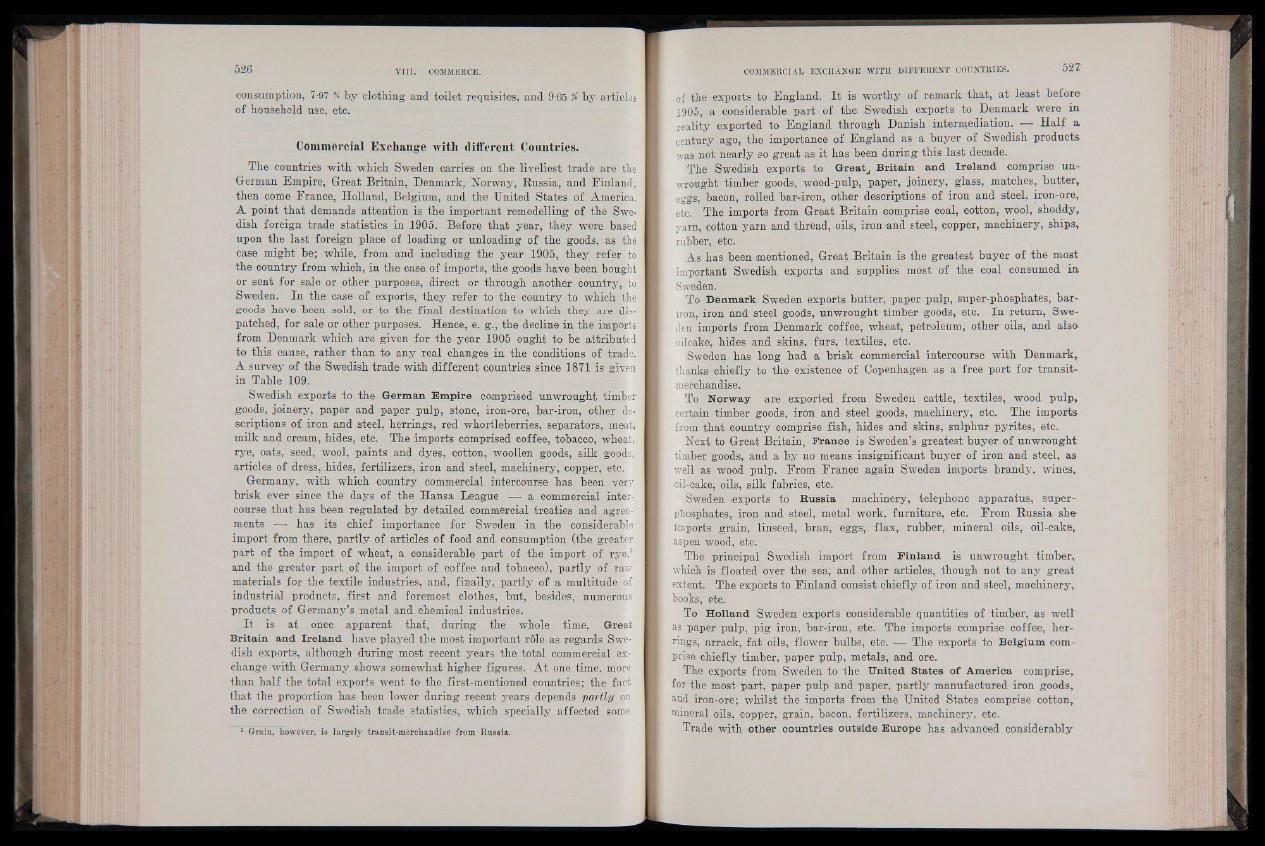
consumption, 7-97 % by clothing and toilet requisites, and 9-65 % by articles
of household use, etc.
Commercial Exchange with different Countries.
The countries with which Sweden carries on the liveliest trade are the
German Empire, Great Britain, Denmark, Norway, Russia, and Finland;
then come France, Holland, Belgium, and the United States of America.
A point that demands attention is the important remodelling of the Swedish
foreign trade statistics in 1905. Before that year, they were based
upon the last foreign place of loading or unloading of the goods, as the
case might be; while, from and including the year 1905, they refer to
the country from which, in the case of imports, the goods have been bought
or sent for sale or other purposes, direct or through another country, to
Sweden. In the case of exports, they refer to the country to which the
goods have been sold, or to the final destination to which they are dispatched,
for sale or other purposes. Hence, e. g., the decline in the imports
from Denmark which are given for the year 1905 ought to be attributed
to this cause, rather than to any real changes in the conditions of trade,
A survey of the Swedish trade with different countries since 1871 is given
in Table 109.
Swedish exports to the German Empire comprised unwrought timber
goods, joinery, paper and paper pulp, stone, iron-ore, bar-iron, other descriptions
of iron and steel, herrings, red whortleberries, separators, meat,
milk and cream, hides, etc. The imports comprised coffee, tobacco, wheat,
rye, oats, seed, wool, paints and dyes, cotton, woollen goods, silk goods,
articles of dress, hides, fertilizers, iron and steel, machinery, copper, etc.
Germany, with which country commercial intercourse has been very
brisk ever since the days of the Hansa League — a commercial intercourse
that has been regulated by detailed commercial treaties and agreements
— has its chief importance for Sweden in the considerable
import from there, partly of articles of food and consumption (the greater
part of the import of wheat, a considerable part of the import of rye,1
and the greater part of the import of coffee and tobacco), partly of raw
materials for the textile industries, and, finally, partly of a multitude of
industrial products, first and foremost clothes, but, besides, numerous
products of Germany’s metal and chemical industries.
It is at once apparent that, during the whole time, Great
Britain and Ireland have played the most important rôle as regards Swedish
exports, although during most recent years the total commercial exchange
with Germany shows somewhat higher figures. At one time, more
than half the total exports went to the first-mentioned countries; the fact
that the proportion has been lower during recent years depends partly on
the çorrection of Swedish trade statistics, which specially affected some
1 Grain, however, is largely transit-merchandise from Rnssia.
■ of the exports to England. It is worthy of remark that, at least before-
[ 1905, a considerable part of the Swedish exports to Denmark were in
reality exported to England through Danish intermediation. — Half a
I century ago, the importance of England as a buyer of Swedish products
was not nearly so great as it has been during this last decade.
The Swedish exports to Greatj Britain and Ireland comprise unwrought
timber goods, wood-pulp, paper, joinery, glass, matches, butter,
i eggs, bacon, rolled bar-iron, other descriptions of iron and steel, iron-ore,
etc. The imports from Great Britain comprise coal, cotton, wool, shoddy,
f yarn, cotton yarn and thread, oils, iron and steel, copper, machinery, ships,
I rubber, etc.
As has been mentioned, Great Britain is the greatest buyer of the most
important Swedish exports and supplies most of the coal consumed in
Sweden.
To Denmark Sweden exports butter, paper pulp, super-phosphates, bar-
I iron, iron and steel goods, unwrought timber goods, etc. In return, Swe-
| den imports from Denmark coffee, wheat, petroleum, other oils, and also
oilcake, hides and skins, furs, textiles, etc.
(Sweden has long had a brisk commercial intercourse with Denmark,
thanks chiefly to the existence of Copenhagen as a free port for transit-
merchandise.
To Norway are exported from Sweden cattle, textiles, wood pulp,
i certain timber goods, iron and steel goods, machinery, etc. The imports
f from that country comprise fish, hides and skins, sulphur pyrites, etc.
Next to Great Britain, France is Sweden’s greatest buyer of unwrought
[ timber goods, and a by no means insignificant buyer of iron and steel, as
I well as wood pulp. From France again Sweden imports brandy, wines,
I oil-cake, oils, silk fabrics, etc.
Sweden .exports to Russia machinery, telephone apparatus, super-
[ phosphates, iron and steel, metal work, furniture, etc. From Russia she
! imports grain, linseed, bran, eggs, flax, rubber, mineral oils, oil-cake,
aspen wood, etc.
The principal Swedish import from Finland is unwrought timber,
[ which is floated over the sea; and other articles, though not to any great
| extent. The exports to Finland consist chiefly of iron and steel, machinery,
hooks-, etc.
To Holland Sweden exports considerable quantities of timber, as well'
[ as paper pulp, pig iron, bar-iron, etc. The imports comprise coffee, her-
l rings, arrack, fat oils, flower bulbs, etc. The exports to Belgium comprise
chiefly timber, paper pulp, metals, and ore.
The exports from Sweden to the United States o f America comprise,
I for the most part, paper pulp and paper, partly manufactured iron goods,
I and iron-ore; whilst the imports from the United States comprise cotton,
I, mineral oils, copper, grain, bacon, fertilizers, machinery, etc.
Trade with other countries outside Europe has advanced considerably